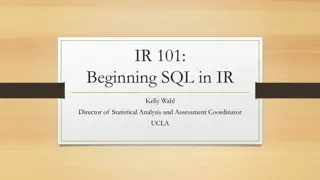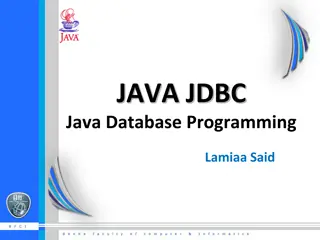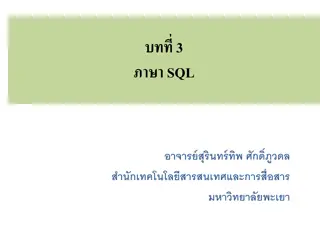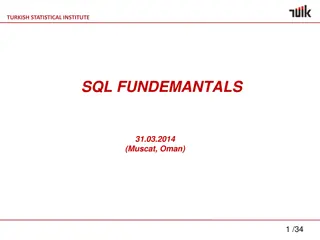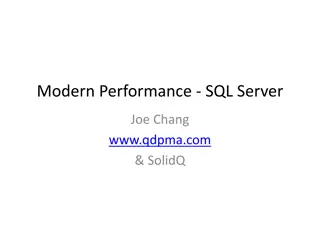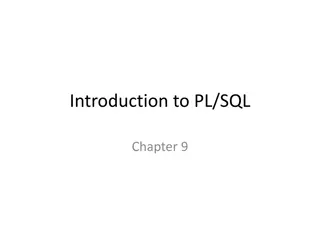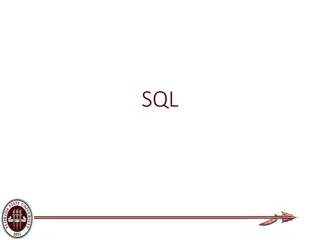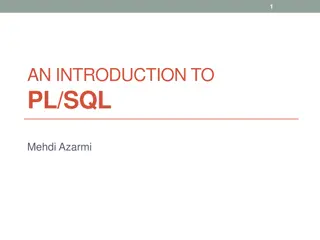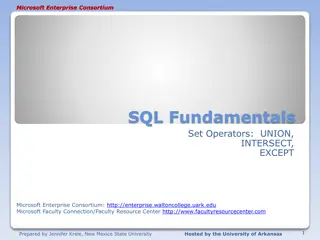Introduction to SQL Basics: The Standard Language for Data Querying and Manipulation
SQL, or Structured Query Language, is a powerful tool for querying and manipulating relational data. Developed in the early 1970s, SQL has evolved into a standard language with various versions such as SQL92, SQL3, SQL99, and SQL2016. It offers a declarative approach, allowing programmers to focus on queries rather than data manipulation details. The language is case-insensitive, with statements ending in semicolons. Components of SQL include Data Definition Language (DDL) and Data Manipulation Language (DML). Key concepts like creating tables and declaring keys are essential in SQL. Overall, SQL optimization over the years has led to efficient query execution.
Download Presentation

Please find below an Image/Link to download the presentation.
The content on the website is provided AS IS for your information and personal use only. It may not be sold, licensed, or shared on other websites without obtaining consent from the author.If you encounter any issues during the download, it is possible that the publisher has removed the file from their server.
You are allowed to download the files provided on this website for personal or commercial use, subject to the condition that they are used lawfully. All files are the property of their respective owners.
The content on the website is provided AS IS for your information and personal use only. It may not be sold, licensed, or shared on other websites without obtaining consent from the author.
E N D
Presentation Transcript
Introduction SQL is the standard language for querying and manipulating (relational) data (https://www.sql50.com) o SQL stands for Structured Query Language o Initially developed at IBM by Donald Chamberlin and Raymond Boyce in the early 1970s, and called SEQUEL (Structured English Query Language) o Many standards out there: SQL92, SQL3, SQL99, , SQL2016 o (Caveats)Vendors support various subsets of these standards Why SQL? 1. A very-high-level, declarative language, in which the programmer is able to avoid specifying a lot of data-manipulation details that would be necessary in languages like C++ 2. Its queries are optimized quite well over the years, yielding efficient query execution and performance
Components of SQL DDL Data Definition Language o Define and modify schema DML Data Manipulation Language o Query (glorified search) data o Insert data o Remove data o Update data
Some SQL syntax SQL is case-insensitive o In general, upper- and lower-case characters are the same, except inside quoted strings Single quote for a string. Two single quotes inside a string represent the single- quote (apostrophe) Each statement finishes with a semicolon (;).
Create Table Format: CREATE TABLE <name> ( <list of elements> ); Each element is a pair consisting of an attribute and a type The most common types are: o INT or INTEGER (synonyms) o REAL or FLOAT (synonyms) o CHAR(n ) = fixed-length string of n characters o VARCHAR(n ) = variable-length string of up to n characters
Create Table - example CREATE TABLE Sells ( bar CHAR(20), beer VARCHAR(20), price REAL );
Declaring keys An attribute or list of attributes may be declared PRIMARY KEY or UNIQUE o Each says the attribute(s) so declared functionally determines all the attributes of the relation schema o There can be only one PRIMARY KEY for a relation, but several UNIQUE attributes o No attribute of a PRIMARY KEY can ever be NULL in any tuple. But attributes declared UNIQUE may have NULL s, and there may be several tuples with NULL o Single attribute keys CREATE TABLE Beers ( name CHAR(20) UNIQUE, manf CHAR(20) );
Multi-attribute keys CREATE TABLE Sells ( bar CHAR(20), beer VARCHAR(20), price REAL, PRIMARY KEY (bar, beer) );
Other Declarations for Attributes Two other declarations we can make for an attribute are: o NOT NULL means that the value for this attribute may never be NULL o DEFAULT <value> says that if there is no specific value known for this attribute s component in some tuple, use the stated <value> CREATE TABLE Drinkers ( name CHAR(30) PRIMARY KEY, addr CHAR(50) DEFAULT 123 Monroe St. , phone CHAR(16) );
Other useful SQL DDL commands Add an attribute to a table ALTER TABLE Bars ADD phone CHAR(10) DEFAULT unlisted ; Remove an attribute from a table ALTER TABLE Bars DROP license; Remove a table DROP TABLE Bars
Insert a new record into a table The insert into statement inserts a new record into a table o INSERT INTO table_name (column1, column2, column3, ...) VALUES (value1, value2, value3, ...); o INSERT INTO table_name VALUES (value1, value2, value3, ...);
Insert into example CREATE TABLE Drinkers ( name CHAR(30) PRIMARY KEY, addr CHAR(50) DEFAULT 123 Monroe St. , phone CHAR(16) ); Insert into Drinkers(name, addr, phone) Values ( John Smith', 201 Marty Ln', 555-666-7777 ) NAME ADDR PHONE John Smith 201 Marty Ln 555-666-7777
Insert into example o Insert into Drinkers(namInsert into Drinkers(name, phone) Values ( Sophie Green , 111-222-3333 ) o e) Values ( John Doe ) NAME ADDR PHONE John Smith 201 Marty Ln 555-666-7777 Sophie Green 123 Monroe St. 111-222-3333 John Doe 123 Monroe St. NULL
Write SQL commands to create the following table EmployeeID LastName FirstName DeptID Age 001 John Smith 100 20 Employees 002 Why Me NULL NULL 003 What NULL NULL 18
SQL query SELECT-FROM-WHERE statements o SELECT: desired attributes, expressions from the attributes o FROM: one or more tables o WHERE: condition about tuples of the table o Using table Beers(name, manf) to find all beers made by Busch. SELECT name FROM Beers WHERE manf = Busch o The answer is a relation with a single attribute name, and tuples with the name of each beer by Busch, such as Bud
Single-Relation Query Operations 1. 2. 3. Begin with the relation in the FROM clause Apply the condition indicated by the WHERE clause to each tuple Select the fields (or expressions from the fields) indicated by the SELECT clause Semantics 1. To implement this algorithm, think of a tuple variable ranging over each tuple of the relation mentioned in FROM Check if the current tuple satisfies the WHERE clause If so, compute the attributes or expressions of the SELECT clause using the components of this tuple 2. 3.
Single-relation query example SELECT name FROM Beers WHERE manf = Busch Beers Name manf Name manf Bud Busch Bud Busch Miller Lite MillerCoors Bud Lite Busch Bud Lite Busch Michelob Busch Blue Moon Molson Coors Corona Extra Constellation Brands AB InBev Name Michelob Busch Bud Bud Lite Michelob
* In SELECT clauses When there is one relation in the FROM clause, * in the SELECT clause stands for all attributes of this relation. Example using Beers(name, manf): Name manf SELECT * Bud Busch FROM Beers Bud Lite Busch Michelob Busch WHERE manf = Busch ;
Renaming Attributes If you want the result to have different attribute names, use AS <new name> to rename an attribute Example using Beers(name, manf): Beer manf SELECT name AS beer, manf Bud Busch FROM Beers Bud Lite Busch Michelob Busch WHERE manf = Busch ;
Expressions in SELECT clauses Any expression that makes sense can appear as an element of a SELECT clause Example: from Sells(bar, beer, price): SELECT bar, beer, price * 132 AS priceInYen FROM Sells; Sells Bar Beer Price Bar Beer PriceInYen Sue Bar Bud 1.00 Sue Bar Bud 132.00 Joe Bar Bud 2.00 Joe Bar Bud 264.00 Fat Daddy Bud 3.00 Fat Daddy Bud 396.00
Complex Conditions in WHERE Clause What you can use in WHERE: o attribute names of the relation(s) in FROM o comparison operators: =, <>, <, >, <=, >= o apply arithmetic operations: stockprice*2 o operations on strings (e.g., || for concatenation) o Lexicographic order on strings o Pattern matching: s LIKE p o Special stuff for comparing dates and times. o Conditions in the WHERE clause can use AND, OR, NOT, and parentheses in the usual way Boolean conditions are built
Complex Conditions in WHERE Clause From Sells(bar, beer, price), find the price Joe s Bar charges for cheap beers: SELECT price FROM Sells WHERE bar = Joe Bar AND price < 5.0;
Pattern in WHERE clause WHERE clauses can have conditions in which a string is compared with a pattern, to see if it matches General form: <Attribute> LIKE <pattern> or <Attribute> NOT LIKE <pattern> o Pattern is a quoted string with % = any string ; _ = any character. From Drinkers(name, addr, phone) find the drinkers with exchange 555: SELECT name FROM Drinkers WHERE phone LIKE %555-_ _ _ _ ;
NULL value Tuples in SQL relations can have NULL as a value for one or more components. Its Meaning depends on context; Two common cases: o Missing value : e.g., we know Joe s Bar has some address, but we don t know what it is o Inapplicable : e.g., the value of attribute spouse for an unmarried person When any value is compared with NULL, the result value is an UNKNOWN The logic of conditions in SQL is really a 3-valued logic: TRUE, FALSE, UNKNOWN o A query only produces a tuple in the answer if its value for the WHERE clause is TRUE (not FALSE or UNKNOWN)
Example Sells bar beer Price Joe s Bud NULL SELECT BAR FROM SELLS WHERE PRICE < 2.00 OR PRICE >= 2.00 UNKNOWN UNKNOWN UNKNOWN
Three-valued logic To understand how AND, OR, and NOT work in 3-valued logic, think of TRUE = 1, FALSE = 0, and UNKNOWN = , AND = MIN; OR = MAX, NOT(x) = 1-x. Example: TRUE AND (FALSE OR NOT(UNKNOWN)) = MIN(1, MAX(0, (1 - ))) = MIN(1, MAX(0, ) = MIN(1, ) =
Example Sells (bar, beer, price) bar beer Price Joe s Bud Lite NULL Joe s Bud NULL Big Mama Bud 2.00 SELECT bar FROM Sells WHERE beer = Bud OR price < 3.00
Explicit test for NULL Can test for NULL explicitly: o x IS NULL o x IS NOT NULL SELECT * FROM Person WHERE age < 25 OR age >= 25 OR age IS NULL
Exercise From Sells(bar, beer, price), find the bars that sell Bud Lite for less than 4 dollars.
Exercise From Students(Sid, SSN, LName, FName, Phone, GPA), find the student id, last name, first name, and GPA of all students whose GPA is above 3.5 and whose phone number has an area code of 850 (phone number format: xxx-xxx-xxxx).
More Exercise From Sells(bar, beer, price), find the prices and beers that are sold by Joe s either for less than $2 or for an unknown price.
Multi-relation Queries Interesting queries often combine data from more than one relation, we can address several relations in one query by listing them all in the FROM clause. Basic multi-relation queries: o The Cartesian product of the multiple relations in the FROM clause: o Use relations Likes(drinker, beer) and Frequents(drinker, bar) for the following query. Let Likes have 4 tuples and Frequents have 6 tuples, how many columns are in the output of the following query? How many tuples? SELECT * FROM Likes, Frequents
Multi-relation Queries Attributes in different relations may have the same name. Distinguish attributes of the same name by <relation>.<attribute> Using relations Likes(drinker, beer) and Frequents(drinker, bar) for the following query. Let Likes have 4 tuples and Frequents have 6 tuples, how many columns are in the output of the following query? How many tuples? SELECT Likes.drinker, Likes.beer FROM Likes, Frequents
Multi-relation Queries Query: Using relations Likes(drinker, beer) and Frequents(drinker, bar), find the beers liked by at least one person who frequents Joe s Bar.
Multi-relation Queries Query: Using relations Likes(drinker, beer) and Frequents(drinker, bar), find the beers liked by at least one person who frequents Joe s Bar. SELECT Likes.beer FROM Likes, Frequents WHERE Frequents.bar = Joe Bar AND Frequents.drinker = Likes.drinker;
Semantics Almost the same as for single-relation queries: 1. 2. 3. Start with the (Cartesian) product of all the relations in the FROM clause Apply the selection condition from the WHERE clause Project onto the list of attributes and expressions in the SELECT clause SELECT a1, a2, , ak FROM R1 AS x1, R2 AS x2, , Rn AS xn WHERE Conditions
Semantics SELECT a1, a2, , ak FROM R1 AS x1, R2 AS x2, , Rn AS xn WHERE Conditions Answer = {} for x1 in R1 do for x2 in R2 do .. for xn in Rn do if Conditions thenAnswer = Answer U {(a1, ,ak)} return Answer
Multi-relation queries exercise Query: Using relations Likes(drinker, beer) and Sells(bar, beer, price), find the bars that sell beers that Kate likes.
Multi-relation queries exercise Query: Using relations Likes(drinker, beer) and Frequents(drinker, bar), Sells(bar, beer, price), find the beers and Joe s prices for the beers that some Joe s frequent customers like.
Explicit Tuple Variables Sometimes, a query needs to use two copies of the same relation o Distinguish copies by following the relation name with the name of a tuple-variable, in the FROM clause o It s always an option to rename relations this way, even when not essential SELECT s1.bar, s1.beer, s1.price FROM Sells s1, Sells s2 WHERE s1.beer = s2.beer AND s1.price < s2.price;
Exercise From students(Sid, SSN, LName, FName, Phone, GPA) and takes(Sid, course), what does the following query do? SELECT t.course FROM students s, takes t WHERE s.FName = Ashley AND s.LName = Brown AND s.sid = t.sid;
Exercise From students(Sid, SSN, LName, FName, Phone, GPA) and takes(Sid, course), find the student id, and first and last names of students who take COP4521.
SubQueries A parenthesized SELECT-FROM-WHERE statement (subquery) can be used as a value in a number of places, including FROM and WHERE clauses o Example: in place of a relation in the FROM clause, we can place another query, and then query its result Better use a tuple-variable to name tuples of the result Subqueries that return Scalar o If a subquery is guaranteed to produce one tuple with one component, then the subquery can be used as a value Single tuple often guaranteed by the key constraint A run-time error occurs if there is no tuple or more than one tuple
Subquery example From Sells(bar, beer, price), find the bars that serve Miller for the same price Joe charges for Bud 1. Find the price Joe charges for Bud 2. Find the bars that serve Miller at that price SELECT bar FROM Sells WHERE beer = Miller AND price = (SELECT price FROM Sells WHERE bar = Joe Bar AND beer = Bud )
The IN Operator <tuple> IN <relation> is true if and only if the tuple is a member of the relation o <tuple> NOT IN <relation> means the opposite o IN-expressions can appear in WHERE clauses o The <relation> is often a subquery Query: From Beers(name, manf) and Likes(drinker, beer), find the name and manufacturer of each beer that Sally likes SELECT * FROM Beers WHERE name IN ( SELECT beer FROM Likes WHERE drinker = Sally );
Exercise Use subquery to do the following: From students(Sid, SSN, LName, FName, Phone, GPA) and takes(Sid, course), find the student id, and first and last names of students who take COP4521.
Exercise Query: Using relations Likes(drinker, beer) and Frequents(drinker, bar), Sells(bar, beer, price), find the beers that some Joe s frequent customers like, but not sold by Joe s.
Exercise Query: Using relations Likes(drinker, beer) and Frequents(drinker, bar), Sells(bar, beer, price), find the beers that some Joe s frequent customers like, but not sold by Joe s. SELECT Likes.beer FROM Likes, Frequents WHERE Likes.drinker = Frequents.drinker AND frequents.bar = Joe s AND likes.beer NOT IN (SELECT beer FROM Sells WHERE bar = Joe s );
The EXISTS Operator EXISTS( <relation> ) is true if and only if the <relation> is not empty o Being a Boolean-valued operator, EXISTS can appear in WHERE clauses Query: From Beers(name, manf), find those beers that are the only beer by their manufacturer SELECT name FROM Beers b1 WHERE NOT EXISTS( SELECT * FROM Beers WHERE manf = b1.manf AND name <> b1.name); Scope rule: manf refers to closest nested FROM with a relation having that attribute.
The Operator ANY x = ANY( <relation> ) is a Boolean condition meaning that x equals at least one tuple in the relation Similarly, = can be replaced by any of the comparison operators o Example: x >= ANY( <relation> ) means x is not smaller than some tuples in the relation o Note tuples must have one component only


